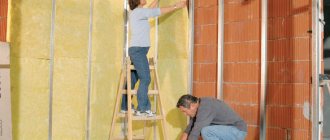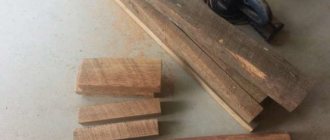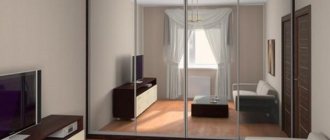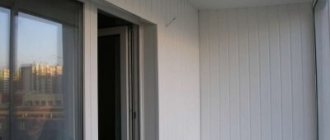How to level the ceiling in an apartment or house with putty?
If you need to level the ceiling, first you need to determine the difference in height, that is, its curvature. To do this, use a hydraulic level and measure the height at all four corners. The minimum height is the final point at which the ceiling will need to be leveled. The best option is if the difference is insignificant, that is, small, up to 1 cm. In this case, you will be able to level it using starting and finishing putty.
Instructions:
- First, the old coating is removed and the whitewash is completely washed off. All dents and depressions are sealed with plaster. Next, a primer is applied, which, after complete drying, is covered with a thick layer of starting putty.
- Next, you need to let it dry for 2 days. After this, a new layer of primer and the finishing layer are applied again. Do not try to remove the material very carefully, because it is useless. This can be done in the next stages of leveling.
- After the finishing putty has dried, it must be covered with the thinnest layer of finely dispersed putty, which is applied in a layer of up to half a millimeter.
- After this, the ceiling is polished using special polymer mesh and sandpaper, and the ceiling is leveled. Sanding is carried out, after which any remaining dust is removed. The surface is primed and you can begin further finishing manipulations - painting, whitewashing.
Leveling with putty
Ceiling preparation
With “wet” methods of leveling the ceiling, you need to be especially careful when preparing the base, because mistakes made at this stage can lead to peeling of the plaster in the future.
- removal of old plaster - if the ceiling has already been plastered, then the coating does not always need to be removed. This issue is resolved separately for each specific case, since this procedure is quite labor-intensive if you do the ceiling leveling yourself. If you hire a professional, dismantling the old coating will increase the cost of the work.
To make a decision on old plaster, it is necessary to carry out diagnostics. The reason for removing the finish may be cracks on the surface or mold stains. You should also try to tear off the coating with a spatula; if it begins to crumble, the plaster will have to be removed. You can also tap the plaster for diagnostics. If the surface “swells”, then voids have formed underneath, such a layer will be a poor base for a new finish.
To remove old plaster, you can use a hammer drill, axe, hammer or narrow spatula.
- Washing off the whitewash is a mandatory procedure before plastering work. Whitewash was commonly used in older homes. Lime whitewashes are especially dangerous: over time they crystallize and lose adhesion - the weight of the plaster can tear it away from the base
- cracks must be repaired using plaster or putty. You also need to add reinforcement; perforated tape or sickle mesh is suitable for this.
For more information about sealing cracks with putty, read the advice “How to properly seal a crack with putty: step-by-step instructions.”
- sealing rust - this architectural element spoils the appearance of the ceiling, so it must be dealt with in the same way as with cracks. Before embedding, it must be expanded by 2-3 cm. To do this, you can use a hammer drill. Then the recess is filled with polyurethane foam and puttied. A serpyanka mesh is glued onto the layer of putty, then a finishing layer of putty is applied on top
How to level a crooked ceiling in an apartment or house with a grid?
The task becomes more complicated if the difference between the corners is 2 cm. In this case, you will have to purchase a special mesh, which is made of nylon fibers.
Instructions:
- At the initial stage, it is also necessary to remove the old coating, seal cracks with plaster, and apply a layer of primer.
- After this, bustilate or PVA glue is applied to the mesh and it is glued over the entire surface of the ceiling, its entire area. Next, a layer of putty is applied directly to this mesh, as in the previous case with leveling with putty.
- If the mesh is not secured and a very thick layer of putty is applied, then after drying it will simply fall off. This mesh is a kind of fastening material that glues the ceiling to the putty.
Ceiling leveling
Methods for leveling ceilings
The variety of ceiling leveling methods can be divided into two types: “dry” and “wet”.
- “Wet” leveling methods involve the use of materials that are adhesively bonded to the base. Examples include plastering, tiling, putty, and various adhesive modules. For “wet” methods there is a drying period
- “dry” leveling methods do not involve the use of binders that are adhesively bonded to the base. Only the frame is used, which is mechanically fixed to the base using hardware. The frame is sheathed with sheet material or serves as a basis for tensile structures. This group includes rack, cassette, tension, and suspended types of ceilings
How to level a ceiling with a rotating band?
If the level at the corners of the walls differs by 3 cm, then the option with a mesh will not work.
Instructions:
- It is necessary to use a special reinforcing structure, which is screwed to the ceiling using self-tapping screws. The mesh can be metal with small cells, or nylon. It is attached in the same way at the very first stage.
- After this, rotband plaster from the Knauf company is applied. This is a special gypsum mixture that allows you to eliminate even decent unevenness.
- It is applied in a thick layer of 2 cm, and then leveled using starting and finishing putty. Please note that each layer must be treated with a primer for good adhesion and adhesion of one layer to another. How to apply putty, see the first example.
Rotband
Tools for removing old coatings
Before leveling the ceiling, you must prepare its surface by removing whitewash, old paint and other coatings. It all depends on how carefully you do it. It is better to clean the surface with a spatula or scraper. Using these devices you can get rid of dry paint.
But if you want to cost less and reduce preparation time, then it is better to moisten the ceiling surface with water, eliminating the draft in the room. The old coating will begin to bubble under such conditions. After this, you can remove the remnants of the old finish. Then the base is washed well.
How to level a plasterboard ceiling with your own hands?
If the difference in the corners of the walls is significantly more than 5 cm, the only option here is to install a suspended ceiling. It may not be suspended; plasterboard ceilings are often installed.
Instructions:
- To do this, the surface is treated, dirt is removed and irregularities and dents are repaired.
- They are coated with a primer, after which the sheathing is installed, which consists of metal profiles.
- In this way, a kind of frame is made, sheets of plasterboard are attached directly to this frame, which is then covered with a thin layer of finishing putty, and after that further processing can be carried out.
- This option is suitable if you are not a fan of suspended ceilings, but want to glue tiles or wallpaper to the ceiling.
- In this case, drywall will help you level the ceiling without buying a huge amount of putty, without making the structure heavier, and also save time and money.
- In addition, the plasterboard construction allows you to create multi-level ceilings using interesting, unusual decor.
- Very often, backlighting is installed; tension surfaces can be made with photo printing.
- Nowadays the combination of plasterboard and suspended ceilings is very popular.
Lathing for drywall
Ceiling plinth
If the joints between the walls and the upper part of the room have flaws after cosmetic repairs or the actions of not very qualified workers, it is enough to add a suitable baseboard - and the room will “sparkle” in a new way.
Also often used:
- polyurethane cornices;
- moldings.
Both should be approximately the same size as the floor plinth. If you paint the cornices the same color as the ceiling, you can additionally “raise” the ceiling in a not very spacious room.
Flat stretch ceiling: advantages
Please note that there is a huge selection of both glossy and matte films. You can choose a design that interests you on the Internet and bring it to life on the ceiling. This is an excellent opportunity for parents of small children who want to make the nursery quite interesting and unusual. At the same time, installation of suspended ceilings takes a minimum of time. This is especially true if there are already special grooves that are installed around the perimeter of the entire room. The craftsmen can do the work itself in just a few hours. That is, without dust, without dirt and endless cleaning of floors, you will get a completely flat ceiling.
Using stretch films, you can create the illusion of a perfectly flat, white whitewashed ceiling. At the same time using a white matte film. The advantages of such ceilings are that they do not deteriorate when water flows onto them; it will be enough to drain the water through the hole for the chandelier and re-stretch the film using a gas burner. In this case, the surface is completely restored and does not deteriorate. In fact, stretch ceilings are not as expensive as it seems at first glance. If you compare it with the amount of putty spent on leveling a crooked ceiling, then the use of suspended ceilings allows you to save significantly.
Stretch ceiling
As you can see, it makes sense to level the ceiling on your own if the curvature is small, up to one centimeter. You can use a small amount of putty and level the ceiling on your own. Otherwise, if there are significant differences in height, we advise you to contact specialists and get a stretch or suspended ceiling.
Leveling technique using putty
If you want to know how to level a ceiling, you should consider that putty is excellent for this. Its application is carried out with a wide spatula, onto the working surface of which the composition is applied with a narrow spatula. The mixture is then transferred to the ceiling.
It’s worth wasting time on straightening out the divorces. They will be removed with a grout mesh after hardening. Once the last layer of putty has dried, the base can be sanded. For this, grout with a mesh is used. Its minimum roughness should be 120 units.
Leveling with drywall
Before leveling the ceiling for painting, you must decide what material to use. You can use plaster and putty, which are often replaced with drywall. It allows you to carry out work using the dry method. This helps to hide surface defects and place communications in the hollow space of the ceiling.
This type of work is suitable for surfaces with significant differences in height. Installing a plasterboard ceiling allows you to reduce time and financial costs. After installing the structure, you will receive a flat surface that will be ready for further decorative finishing.
A plasterboard ceiling is a structure that consists of metal profiles and the cladding sheet itself. From the first, a frame is assembled to which the canvases are fixed. To perform leveling work, it will be necessary to mark the position of the ceiling. Next, the points where the suspensions will be attached are indicated. These elements hold the structure in place.
Building materials and their features
Typically, when leveling walls and ceilings, plaster is used - gypsum, lime and alabaster. There are four types of its varieties: magnesium and gypsum mixtures, lime and cement-sand mortars.
Before answering the question of how to level ceilings, you should study the features of building materials.
Gypsum mixtures make it possible to obtain an even white coating. Significant disadvantages are a low level of moisture resistance, high cost, poor vapor permeability and low strength. Among the advantages, it should be noted the fast leveling process and the simplified finishing technological cycle.
Lime mortars are highly environmentally friendly. In addition, they allow finishing work to be completed in the shortest possible time. Disadvantages include relatively low strength.
Cement-sand mortars are considered the cheapest materials. Compared to the options described above, they are stronger, but working with them requires a certain qualification from the master. The advantages include a long service life, which can last for decades, and the ability to level surfaces with large flaws.
Non-flammable, dust-free and high-strength materials include magnesium mixtures. They are well adapted for gluing wallpaper and applying paint.
"Wet" leveling
This method is associated with special leveling solutions that are applied to the ceiling surface. They must have a high level of bonding, just like the surface being treated, which must be brought to the maximum adhesion level before applying them.
Before you begin leveling, you should decide on the method. The main selection criterion is the difference in the ceiling plane. If it exceeds 50 millimeters, then you should not think about wet options. After all, a plaster layer of such thickness will not adhere to the ceiling surface, even if a reinforcing mesh is installed on it. Therefore, there is only one way out - to mount a suspended or tensioned structure.
If the difference is slightly less than 50 millimeters, then you shouldn’t level it yourself either - it’s better to find a good master. After all, a poorly executed layer of, for example, 3 centimeters will not be of high quality. But you can remove a small difference yourself. Plus, the wet method will save you centimeters of height, which is an important factor.
Preparatory stage
Ceiling repair begins with the complete removal of the old finish. You should not look at whether it adheres well to the ceiling surface. Remove the trim completely.
For this:
- Beat off the plaster with a hammer and a sharp spatula.
- Wet the whitewash or water-based emulsion well, and then remove it with a spatula or metal sponge and brush.
- Remove water-dispersion paint with a metal brush attached to a drill (by the way, this is the most difficult type of ceiling finish).
Now you need to check the plaster mortar that was placed in the seams between the floor slabs. If it holds well, then you don’t have to knock it out. And if you are not satisfied with something, then partially delete it.
Attention! If the ceiling has been infected with mold, it must be thoroughly etched with special solutions. But it is best to burn using a gas burner.
And the last process in preparing the ceiling is priming. Apply it with a roller or brush. It is better to choose a deep penetration primer, which will not only create a surface with a high adhesion rate, but also strengthen the concrete ceiling.
Selecting material for leveling
Leveling the ceiling with plasterboard
How to level the ceiling? Everything again depends on the difference in the plane. There are two types of putty solutions, which differ from each other in the density and granularity of the filler.
If the plane difference is from 30 to 50 millimeters, then it is better to use Rotband plaster. If the difference is less than 30 millimeters, then use Fugenfüller putty mixture.
The first has a coarse filler grain, the second has a fine grain. But both types are created on a gypsum basis. By the way, very often craftsmen use tow treated with one of the compounds to seal rust between floor slabs. To more firmly hold the mortar at the joints of the plates, a reinforcing mesh is applied to the gap.
We build a lattice and attach drywall
The guides are attached to the ceiling surface at a distance of 60 cm from each other using special self-tapping screws with a flat head.
To extend the guide, you can insert an additional piece, fastening it with rivets. Using crabs, the second part of the lattice is built at the same distance from each other. There is one peculiarity: one of the guides must pass from the wall at a distance of 2.5 meters, since the ceiling can be correctly leveled only using a standard 1.2 x 2.5 m sheet of plasterboard. Using a thread stretched diagonally from one corner of the room, you should make sure there are no deflections in the grille.
Having attached the sheets to the grid, you need to focus on the side of the drywall, it should be the front. You need an assistant in this process. The sheets are fastened with metal screws, recessing the heads into the material at a distance of 20 cm from each other. A gap of 3 mm is left between the sheets. In the place where they are connected by the narrow sides, the side is cut at an angle of 450. If you can’t find an assistant, you can do this process alone using a device made of three boards.











